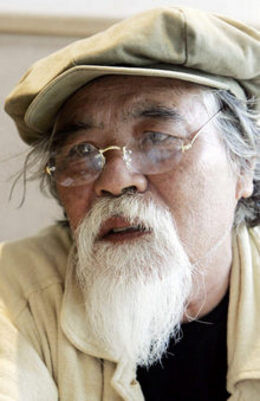hankyoreh
Links to other country sites 다른 나라 사이트 링크
Japanese man wants father’s name removed from Yasukuni

The father of Kinjo Minoru, a 67-year-old sculptor from Okinawa, Japan, volunteered for the Japanese military at the age of 19, during the height of the Pacific War. Three years later, he was killed, and his name enshrined at the Yasukuni Shrine. Kinjo Minoru was 3 years old at the time.
"I don’t remember my father’s face, voice, touch, anything," said Kinjo, who first learned about his father’s memorialization at the shrine in 1985, about 40 years after the fact.
After becoming aware of his father’s enshrinement at Yasukuni, Kinjo came to think about the situation.
"My father, being honored as a god to protect Japanese imperialism, was not only a wrongdoer in an invasive war, but a victim of the imperial system." Though Kinjo’s father volunteered for the war, no family members had known about his enshrinement at Yasukuni. No one in the family wanted his name honored at the shrine.
Kinjo, who is leading a delegation that has filed a lawsuit against the Yasukuni shrine to nullify several disputed memorializations there, met with The Hankyoreh at Tokyo’s Meiji Park on Aug. 14 at a rally opposed to the shrine.
"Memorializing war participants alongside Class A war criminals without any prior agreement is an infringement of religious freedom." He compared the act to "again killing those who were already dead."
Kinjo added, "People from Korea, Taiwan, and Okinawa were sacrificed by being forced to mobilize for Japan’s invasive war. It’s another crime for the government and media to mislead the people, who were sacrificed because they were powerless, as if they died willingly for [imperial] Japan."
For such reasons, Kinjo called repeated visits to the Yasukuni Shrine by Japanese prime minister Junichiro Koizumi and other prominent politicians a "starting point of pathological nationalism and a darkening of Asia’s future."
The root of Japan’s rapid turn toward rightist ideology, including a move to revise its so-called Peace Constitution, is the Yasukuni shrine, Kinjo said. Asian neighbors, who suffered from the brutality of the Japanese military, have no choice but to worry about a resurrection of Japanese militarism, Kinjo added.
Kinjo also played a leading role in winning a ruling that said a prime minister’s official and repeated pilgrimages to the shrine can be seen a violation of Constitutional Article 21 that defines a separation between politics and religion, after filing an anti-constitutional lawsuit against a former Japanese premier Yasuhiro Nakasone. Kinjo is waiting for a ruling in September after filing a similar lawsuit against Koizumi’s pilgrimages to the shrine. After the September ruling, Kinjo plans to aggressively proceed with the lawsuit to nullify disputed memorializations at the shrine.
In 1999, Kinjo set up a monument to the memory of Korean forced laborers sent to Okinawa at a site in Yeongyang County of North Gyeongsang Province in South Korea. In May, he set up a monument in Okinawa in memory of the same victims.
Editorial・opinion
![[Column] Has Korea, too, crossed the Rubicon on China? [Column] Has Korea, too, crossed the Rubicon on China?](https://flexible.img.hani.co.kr/flexible/normal/500/300/imgdb/original/2024/0419/9317135153409185.jpg) [Column] Has Korea, too, crossed the Rubicon on China?
[Column] Has Korea, too, crossed the Rubicon on China?![[Correspondent’s column] In Japan’s alliance with US, echoes of its past alliances with UK [Correspondent’s column] In Japan’s alliance with US, echoes of its past alliances with UK](https://flexible.img.hani.co.kr/flexible/normal/500/300/imgdb/original/2024/0419/2317135166563519.jpg) [Correspondent’s column] In Japan’s alliance with US, echoes of its past alliances with UK
[Correspondent’s column] In Japan’s alliance with US, echoes of its past alliances with UK- [Editorial] Does Yoon think the Korean public is wrong?
- [Editorial] As it bolsters its alliance with US, Japan must be accountable for past
- [Guest essay] Amending the Constitution is Yoon’s key to leaving office in public’s good graces
- [Editorial] 10 years on, lessons of Sewol tragedy must never be forgotten
- [Column] A death blow to Korea’s prosecutor politics
- [Correspondent’s column] The US and the end of Japanese pacifism
- [Guest essay] How Korea turned its trainee doctors into monsters
- [Guest essay] As someone who helped forge Seoul-Moscow ties, their status today troubles me
Most viewed articles
- 1[Column] The clock is ticking for Korea’s first lady
- 2Hong Se-hwa, voice for tolerance whose memoir of exile touched a chord, dies at 76
- 3After 2 months of delayed, denied medical care, Koreans worry worst may be yet to come
- 4[Column] Has Korea, too, crossed the Rubicon on China?
- 5US overtakes China as Korea’s top export market, prompting trade sanction jitters
- 6[Correspondent’s column] In Japan’s alliance with US, echoes of its past alliances with UK
- 7All eyes on Xiaomi after it pulls off EV that Apple couldn’t
- 8Samsung barricades office as unionized workers strike for better conditions
- 9[Photo] Smile ambassador, you’re on camera
- 10[Correspondent’s column] The US and the end of Japanese pacifism